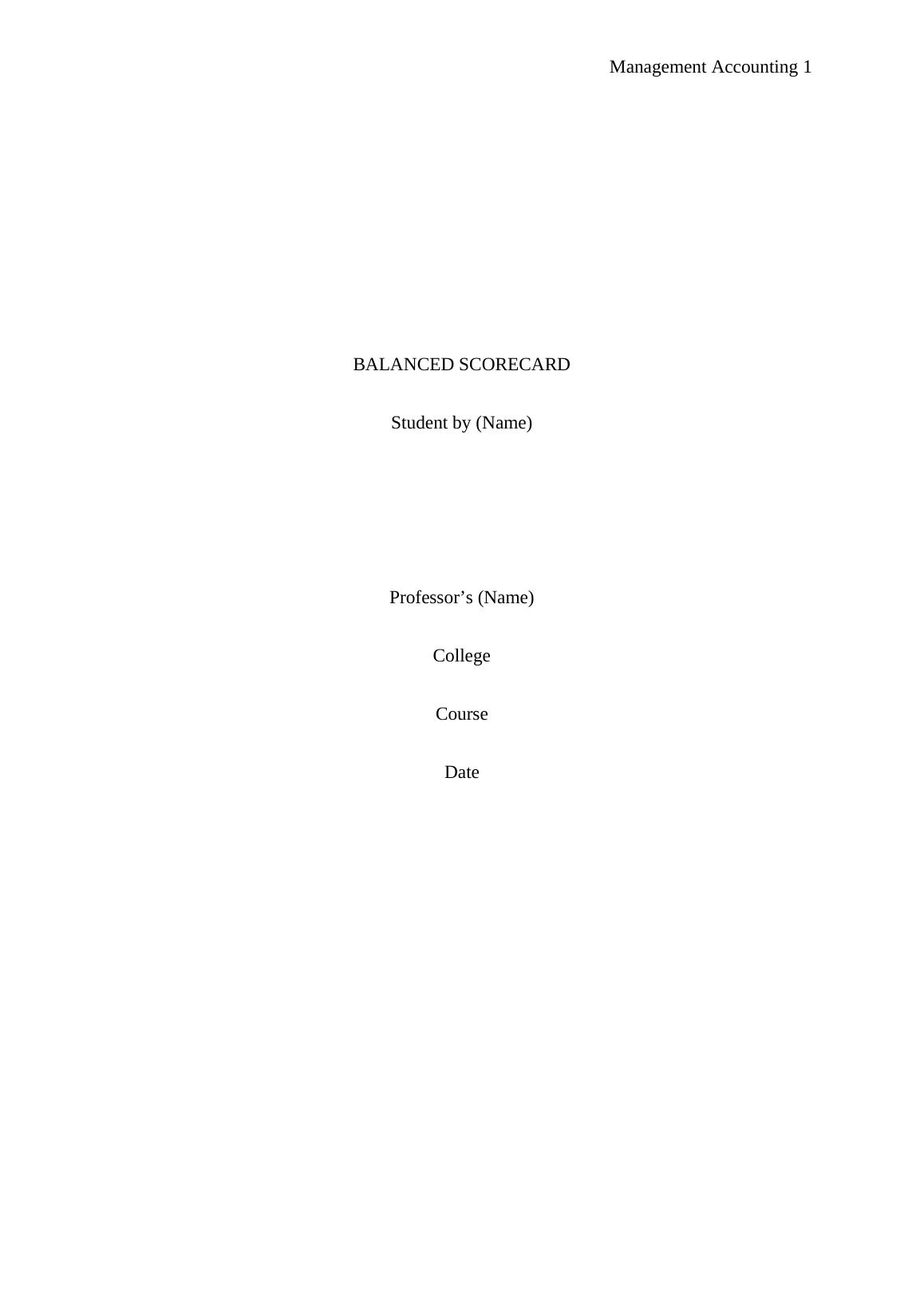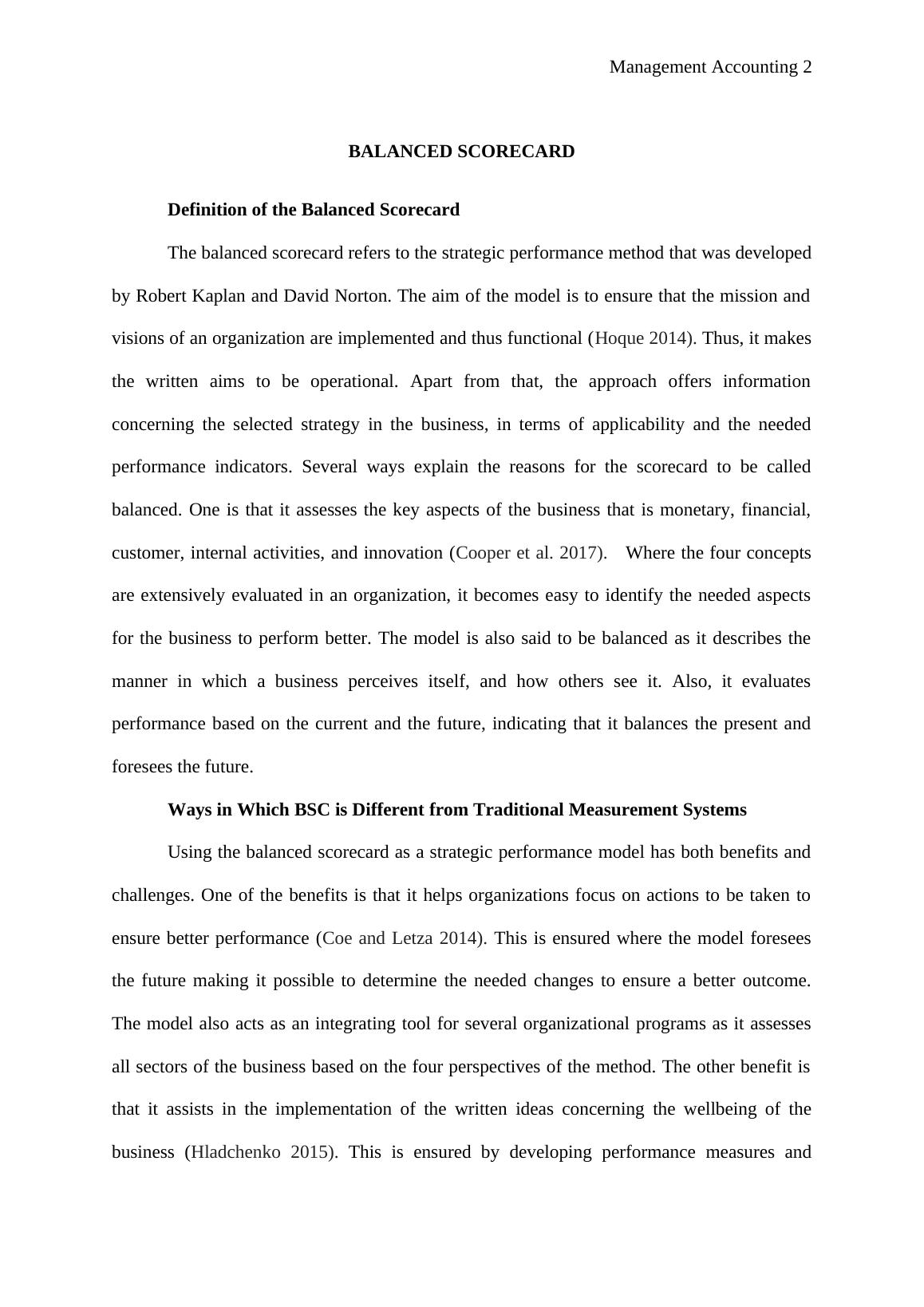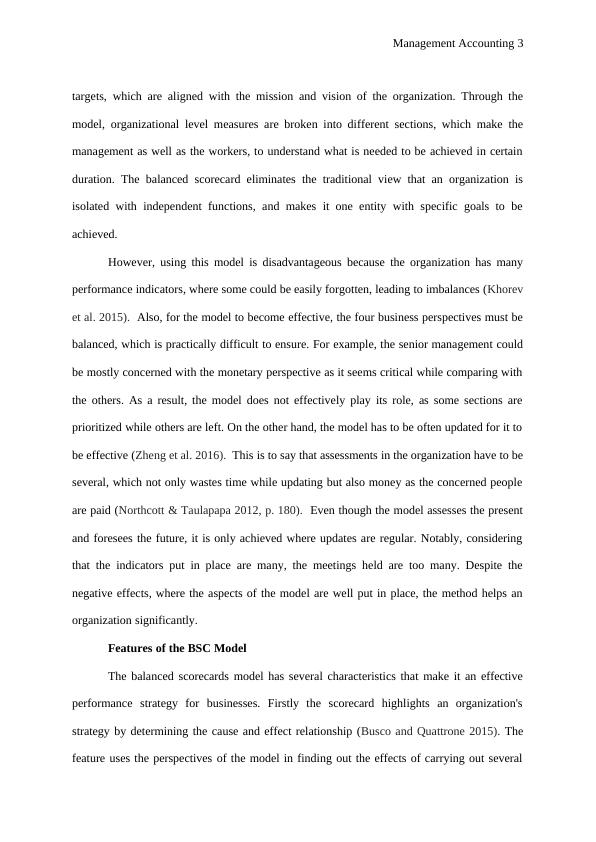Management Accounting Balanced Scorecard
14 Pages4478 Words27 Views
Added on 2021-06-18
Management Accounting Balanced Scorecard
Added on 2021-06-18
ShareRelated Documents
Management Accounting 1
BALANCED SCORECARD
Student by (Name)
Professor’s (Name)
College
Course
Date
BALANCED SCORECARD
Student by (Name)
Professor’s (Name)
College
Course
Date

Management Accounting 2
BALANCED SCORECARD
Definition of the Balanced Scorecard
The balanced scorecard refers to the strategic performance method that was developed
by Robert Kaplan and David Norton. The aim of the model is to ensure that the mission and
visions of an organization are implemented and thus functional (Hoque 2014). Thus, it makes
the written aims to be operational. Apart from that, the approach offers information
concerning the selected strategy in the business, in terms of applicability and the needed
performance indicators. Several ways explain the reasons for the scorecard to be called
balanced. One is that it assesses the key aspects of the business that is monetary, financial,
customer, internal activities, and innovation (Cooper et al. 2017). Where the four concepts
are extensively evaluated in an organization, it becomes easy to identify the needed aspects
for the business to perform better. The model is also said to be balanced as it describes the
manner in which a business perceives itself, and how others see it. Also, it evaluates
performance based on the current and the future, indicating that it balances the present and
foresees the future.
Ways in Which BSC is Different from Traditional Measurement Systems
Using the balanced scorecard as a strategic performance model has both benefits and
challenges. One of the benefits is that it helps organizations focus on actions to be taken to
ensure better performance (Coe and Letza 2014). This is ensured where the model foresees
the future making it possible to determine the needed changes to ensure a better outcome.
The model also acts as an integrating tool for several organizational programs as it assesses
all sectors of the business based on the four perspectives of the method. The other benefit is
that it assists in the implementation of the written ideas concerning the wellbeing of the
business (Hladchenko 2015). This is ensured by developing performance measures and
BALANCED SCORECARD
Definition of the Balanced Scorecard
The balanced scorecard refers to the strategic performance method that was developed
by Robert Kaplan and David Norton. The aim of the model is to ensure that the mission and
visions of an organization are implemented and thus functional (Hoque 2014). Thus, it makes
the written aims to be operational. Apart from that, the approach offers information
concerning the selected strategy in the business, in terms of applicability and the needed
performance indicators. Several ways explain the reasons for the scorecard to be called
balanced. One is that it assesses the key aspects of the business that is monetary, financial,
customer, internal activities, and innovation (Cooper et al. 2017). Where the four concepts
are extensively evaluated in an organization, it becomes easy to identify the needed aspects
for the business to perform better. The model is also said to be balanced as it describes the
manner in which a business perceives itself, and how others see it. Also, it evaluates
performance based on the current and the future, indicating that it balances the present and
foresees the future.
Ways in Which BSC is Different from Traditional Measurement Systems
Using the balanced scorecard as a strategic performance model has both benefits and
challenges. One of the benefits is that it helps organizations focus on actions to be taken to
ensure better performance (Coe and Letza 2014). This is ensured where the model foresees
the future making it possible to determine the needed changes to ensure a better outcome.
The model also acts as an integrating tool for several organizational programs as it assesses
all sectors of the business based on the four perspectives of the method. The other benefit is
that it assists in the implementation of the written ideas concerning the wellbeing of the
business (Hladchenko 2015). This is ensured by developing performance measures and

Management Accounting 3
targets, which are aligned with the mission and vision of the organization. Through the
model, organizational level measures are broken into different sections, which make the
management as well as the workers, to understand what is needed to be achieved in certain
duration. The balanced scorecard eliminates the traditional view that an organization is
isolated with independent functions, and makes it one entity with specific goals to be
achieved.
However, using this model is disadvantageous because the organization has many
performance indicators, where some could be easily forgotten, leading to imbalances (Khorev
et al. 2015). Also, for the model to become effective, the four business perspectives must be
balanced, which is practically difficult to ensure. For example, the senior management could
be mostly concerned with the monetary perspective as it seems critical while comparing with
the others. As a result, the model does not effectively play its role, as some sections are
prioritized while others are left. On the other hand, the model has to be often updated for it to
be effective (Zheng et al. 2016). This is to say that assessments in the organization have to be
several, which not only wastes time while updating but also money as the concerned people
are paid (Northcott & Taulapapa 2012, p. 180). Even though the model assesses the present
and foresees the future, it is only achieved where updates are regular. Notably, considering
that the indicators put in place are many, the meetings held are too many. Despite the
negative effects, where the aspects of the model are well put in place, the method helps an
organization significantly.
Features of the BSC Model
The balanced scorecards model has several characteristics that make it an effective
performance strategy for businesses. Firstly the scorecard highlights an organization's
strategy by determining the cause and effect relationship (Busco and Quattrone 2015). The
feature uses the perspectives of the model in finding out the effects of carrying out several
targets, which are aligned with the mission and vision of the organization. Through the
model, organizational level measures are broken into different sections, which make the
management as well as the workers, to understand what is needed to be achieved in certain
duration. The balanced scorecard eliminates the traditional view that an organization is
isolated with independent functions, and makes it one entity with specific goals to be
achieved.
However, using this model is disadvantageous because the organization has many
performance indicators, where some could be easily forgotten, leading to imbalances (Khorev
et al. 2015). Also, for the model to become effective, the four business perspectives must be
balanced, which is practically difficult to ensure. For example, the senior management could
be mostly concerned with the monetary perspective as it seems critical while comparing with
the others. As a result, the model does not effectively play its role, as some sections are
prioritized while others are left. On the other hand, the model has to be often updated for it to
be effective (Zheng et al. 2016). This is to say that assessments in the organization have to be
several, which not only wastes time while updating but also money as the concerned people
are paid (Northcott & Taulapapa 2012, p. 180). Even though the model assesses the present
and foresees the future, it is only achieved where updates are regular. Notably, considering
that the indicators put in place are many, the meetings held are too many. Despite the
negative effects, where the aspects of the model are well put in place, the method helps an
organization significantly.
Features of the BSC Model
The balanced scorecards model has several characteristics that make it an effective
performance strategy for businesses. Firstly the scorecard highlights an organization's
strategy by determining the cause and effect relationship (Busco and Quattrone 2015). The
feature uses the perspectives of the model in finding out the effects of carrying out several

Management Accounting 4
activities. For example, where an organization wishes to lower its costs of manufacturing, and
therefore increase the growth rate, the scorecard would pinpoint certain objectives as well as
measures in the learning growth approach that could boost the internal organizational
processes. Ensuring this, on the other hand, would lead to better buyers' satisfaction, greater
market share and higher income to the company. The other feature of the model is that it
communicates the initiative developed by the members of the organization and translating it
to a coherent state that is understandable and measurable performances (Kerai and Saleh
2017). By that, the stalk holders of the company carry out actions that depending on the
scorecard analysis of the strategy planned. This is the feature that makes the planned strategy
get implemented in an organization because of employees and the management work towards
the strategy discussed in the scorecard. Therefore, for the model to be useful to an
organization, it has to be developed in the planning stage of projects development so that the
actions are taken later lead to the achievement of the strategy.
The balanced scorecard insists more on the monetary aims and measures, especially to
the profit-seeking businesses (Xia et al. 2017). In most cases, the management of an
organization stresses on innovation and customer satisfaction but tangible advantages are not
evident. The model solves the issue by assessing the non-financial aspects in the business
and interprets how the aspects would result to financial advantages to the business. In doing
this, the model links the non-financial aspects to the financial and where the relationship is
well balanced, monetary benefit is realized (Valmohammadi and Ahmadi 2015). This is to
say that the scorecard model is concerned with the processes that do not bring money into the
business but affects the money earned; indicating that improving the processes would result
to more money to the company. Apart from that, the scorecard reduces the number of
measures of performance used in a business by identifying those that are critical. This is to
say that the model avoids the proliferation of aspects which directs the management to focus
activities. For example, where an organization wishes to lower its costs of manufacturing, and
therefore increase the growth rate, the scorecard would pinpoint certain objectives as well as
measures in the learning growth approach that could boost the internal organizational
processes. Ensuring this, on the other hand, would lead to better buyers' satisfaction, greater
market share and higher income to the company. The other feature of the model is that it
communicates the initiative developed by the members of the organization and translating it
to a coherent state that is understandable and measurable performances (Kerai and Saleh
2017). By that, the stalk holders of the company carry out actions that depending on the
scorecard analysis of the strategy planned. This is the feature that makes the planned strategy
get implemented in an organization because of employees and the management work towards
the strategy discussed in the scorecard. Therefore, for the model to be useful to an
organization, it has to be developed in the planning stage of projects development so that the
actions are taken later lead to the achievement of the strategy.
The balanced scorecard insists more on the monetary aims and measures, especially to
the profit-seeking businesses (Xia et al. 2017). In most cases, the management of an
organization stresses on innovation and customer satisfaction but tangible advantages are not
evident. The model solves the issue by assessing the non-financial aspects in the business
and interprets how the aspects would result to financial advantages to the business. In doing
this, the model links the non-financial aspects to the financial and where the relationship is
well balanced, monetary benefit is realized (Valmohammadi and Ahmadi 2015). This is to
say that the scorecard model is concerned with the processes that do not bring money into the
business but affects the money earned; indicating that improving the processes would result
to more money to the company. Apart from that, the scorecard reduces the number of
measures of performance used in a business by identifying those that are critical. This is to
say that the model avoids the proliferation of aspects which directs the management to focus

End of preview
Want to access all the pages? Upload your documents or become a member.
Related Documents
Performance Management Practices for Business Processes of an Organisationlg...
|9
|1829
|153
Balanced Scorecard Assignment 2022lg...
|14
|3543
|14
Advantages and Critique of Balanced Scorecard in Management Accountinglg...
|7
|1086
|454
Balanced Scorecard: A Strategic Planning and Management Toollg...
|10
|631
|462
Importance of Balanced Scorecard and Decentralized Decision-Making Authority in Business Organizationslg...
|8
|2040
|75
Preparation of Balanced Scorecard for Big C Organisationlg...
|8
|1746
|495
